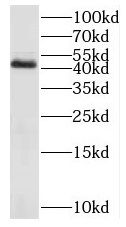Products
MAP2K4 antibody
Category:
Research Area:
| Synonyms: | JNKK antibody, JNKK1 antibody, MAPKK4 antibody, MEK4 antibody, MKK4 antibody, PRKMK4 antibody, SAPKK-1 antibody, SAPKK1 antibody, SEK1 antibody, SERK1 antibody, SKK1 antibody | ||
| Catalogue No.: | FNab10073 | Reactivity: | Human, mouse, Rat |
| Host: | Rabbit | Tested Application: | ELISA, WB, IHC, IF |
| Clonality: | polyclonal | Isotype: | IgG |
- SPECIFICATIONS
- Product Name
- MAP2K4 antibody
- Catalogue No.
- FNab10073
- Size
- 100μg
- Form
- liquid
- Purification
- Immunogen affinity purified
- Purity
- ≥95% as determined by SDS-PAGE
- Clonality
- polyclonal
- Isotype
- IgG
- Storage
- PBS with 0.02% sodium azide and 50% glycerol pH 7.3, -20℃ for 12 months(Avoid repeated freeze / thaw cycles.)
Immunogen
- Immunogen
- MAP2K4
- Alternative Names
- JNKK antibody, JNKK1 antibody, MAPKK4 antibody, MEK4 antibody, MKK4 antibody, PRKMK4 antibody, SAPKK-1 antibody, SAPKK1 antibody, SEK1 antibody, SERK1 antibody, SKK1 antibody
- UniProt ID
- P45985
- Observed MW
- 44 kDa
Application
- Tested Applications
- ELISA, WB, IHC, IF
- Recommended dilution
- WB: 1:500-1:2000; IHC: 1:50-1:500; IF: 1:50-1:100
Validated Images
 Mcf-7 cells were subjected to SDS PAGE followed by western blot with FNab10073(MAP2K4 antibody) at dilution of 1:1000
Mcf-7 cells were subjected to SDS PAGE followed by western blot with FNab10073(MAP2K4 antibody) at dilution of 1:1000
 Immunohistochemistry of paraffin-embedded human breast cancer using FNab10073( MAP2K4 Antibody) at dilution of 1:100
Immunohistochemistry of paraffin-embedded human breast cancer using FNab10073( MAP2K4 Antibody) at dilution of 1:100
 Immunofluorescent analysis of Hela cells using MAP2K4 antibody(FNab10073) at 1:50 dilution.
Immunofluorescent analysis of Hela cells using MAP2K4 antibody(FNab10073) at 1:50 dilution.
- Background
- This gene encodes a member of the mitogen-activated protein kinase (MAPK) family. Members of this family act as an integration point for multiple biochemical signals and are involved in a wide variety of cellular processes such as proliferation, differentiation, transcription regulation, and development. They form a three-tiered signaling module composed of MAPKKKs, MAPKKs, and MAPKs. This protein is phosphorylated at serine and threonine residues by MAPKKKs and subsequently phosphorylates downstream MAPK targets at threonine and tyrosine residues. A similar protein in mouse has been reported to play a role in liver organogenesis. A pseudogene of this gene is located on the long arm of chromosome X. Alternative splicing results in multiple transcript variants.



